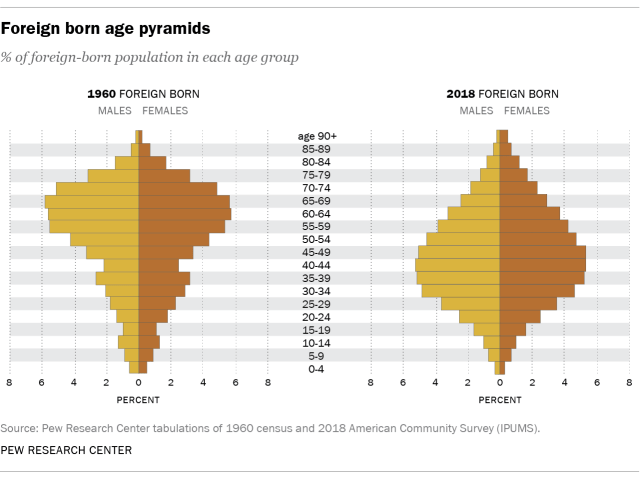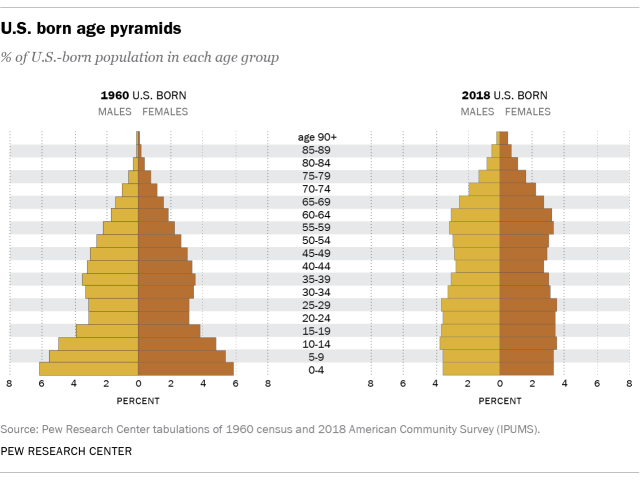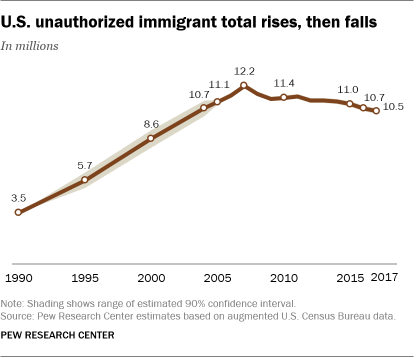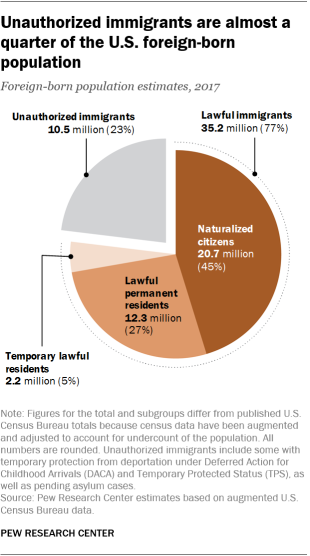What Is The Makeup Of The Illegal Immigrant Population In The United States
Attempt our email course on U.S. immigration

Acquire about immigration through five brusque lessons delivered to your inbox every other twenty-four hour period.
Sign upwardly now!
There were a record 44.8 meg immigrants living in the U.Due south. in 2018, making up 13.7% of the nation's population. This represents a more than than fourfold increment since 1960, when ix.7 million immigrants lived in the U.South., bookkeeping for 5.4% of the full U.Due south. population.
For facts on Latinos in the United States, see our profile on U.S. Hispanics.
For details on our regional grouping of countries, see our "Countries by regional nomenclature" document.
Click the categories beneath to see charts and data.
Population & age | Origin regions | Time in the U.S. & generations
Language utilise & teaching | Unauthorized immigrant population
Population & age
The foreign-built-in population residing in the U.South. reached a record 44.8 million, or 13.seven% of the U.Southward. population, in 2018. This immigrant population has more than quadrupled since the 1960s, when the 1965 Clearing and Naturalization Act took effect. Though growth has begun to slow in recent years, the number of immigrants living in the United States is projected to near double past 2065.
Back to top


The historic period construction of the U.S. immigrant population has changed alongside the changing immigrant origin regions. Equally the largest group of immigrants shifted from Europeans, Canadians and other North Americans to Mexicans, the largest age grouping moved from ages 65-69 in 1960 to ages forty-44 in 2018. Today, European, Canadian and other North American immigrants tend to exist older, with a median age of 53 and 54 respectively in 2018. Mexican immigrants are amongst the youngest, with a median age of 43. The age distribution of the U.South.-born population has as well transformed. In 1960, towards the end of the Baby Boom, the population was younger than in 2018, when these age groups were much more evenly dispersed.
Dorsum to top
Origin regions
The regions of origin for immigrant populations residing in the U.Southward. have dramatically shifted since the passage of the 1965 Immigration and Naturalization Act. In 1960, 84% of immigrants living in the U.Southward. were built-in in Europe, Canada or other Northward American countries, while only half dozen% were from Mexico, 4% from Asia, iii% from the remainder of Latin America and iii% from other areas. Immigrant origins at present differ drastically, with European, Canadian and other North American immigrants making up only a small share of the foreign-built-in population (13%) in 2018. Asians (28%), Mexicans (25%) and other Latin Americans (25%) each brand upward about a quarter of the U.S. immigrant population, followed by 9% who were born in another region.
Back to top
Time in the U.S. & generations
The nation's immigrants are more settled today than they were in 1990, when the share of those who had arrived inside the past 10 years peaked at 44%. At present, the amount of time that immigrants have spent in the U.S. has grown. In 2018, 73% of immigrants had lived in the U.S. for over 10 years, up from 56% in 1990 (simply similar to the share in 1970.)
Back to top
Starting equally early as 2010, more Asian immigrants than Hispanic immigrants have arrived annually in the U.Southward., a reversal of historical trends. In the early 2000s, the number of newly arrived Hispanic immigrants greatly outnumbered newly arrived Asian immigrants. Effectually the time of the Smashing Recession, Latin American clearing declined sharply, especially from Mexico.
CORRECTION (Sept. 21, 2020): An update to the methodology used to tabulate figures in the nautical chart to a higher place has inverse all figures from 2001 and 2012. This new methodology has also immune the inclusion of the figure from 2000. Futhermore, the earlier version of the chart incorrectly showed the fractional year shares of Hispanic and Asian recent arrivals in 2015; the corrected complete twelvemonth shares are 31% and 36%, respectively.
Back to acme
Get-go- and second-generation share of the population, 1900-2018
| Year | 2nd generation | 1st generation |
|---|---|---|
| 1900 | xx.8 | xiii.vii |
| 1910 | 20.one | 14.vi |
| 1920 | 20.6 | 12.7 |
| 1930 | twenty.1 | eleven.iii |
| 1940 | eighteen.8 | eight.5 |
| 1950 | xvi.2 | 6.9 |
| 1960 | 13.8 | 5.6 |
| 1970 | 12.0 | 4.8 |
| 1980 | x.3 | six.2 |
| 1990 | nine.6 | 8.2 |
| 2000 | x.0 | 11.4 |
| 2006 | ten.5 | 12.1 |
| 2010 | 11.iii | 12.7 |
| 2015 | 12.i | 13.three |
| 2016 | 12.0 | 13.5 |
| 2017 | 12.0 | 13.vii |
| 2018 | 12.three | 14.1 |
Pew Research Center
The U.South.-born children of immigrants (second-generation Americans) make upwards 12% of the nation's population. Past 2050, immigrants and their children could account for xix% and 18% of the population, respectively, co-ordinate to Pew Research Centre projections.
Back to tiptop
Language use & educational activity
Since 1980, the share of immigrants who are good in English (those who speak but English at home or speak English at to the lowest degree "very well") has declined, though information technology has increased slightly in contempo years. This decline has been driven entirely by those who speak only English at dwelling, which brutal from 30% of immigrants ages 5 and older in 1980 to 17% in 2018. The share who speaks English "very well," meanwhile, has increased slightly, from 27% to 37% over the same time period.
Back to top
Languages spoken amidst U.S. immigrants, 2018
| Linguistic communication | % of immigrants |
|---|---|
| English language merely | 17% |
| Castilian | 42% |
| Chinese | vi% |
| Hindi | 5% |
| Filipino/Tagalog | 4% |
| French | 3% |
| Vietnamese | iii% |
| Dravidian | 2% |
| Standard arabic | 2% |
| All other | 17% |
Pew Research Eye
Among the nation's immigrants, Spanish is by far the most spoken non-English language language (42% of immigrants say they speak Castilian at domicile), just it is not the only non-English language spoken by immigrants. Some half-dozen% of immigrants speak Chinese (including Mandarin and Cantonese), five% speak Hindi or a related language, four% speak Filipino or Tagalog, three% speak Vietnamese, 3% speak French and ii% speak Dravidian.
Back to superlative
Education levels among the nation'due south immigrants have been steadily rising since the 1960s, just similar the native-born population. While there have been gains across the board, the increases take been virtually dramatic among immigrants from Asia, Europe and the Middle East and less and then amidst those from Mexico and Central America.
Back to top

U.Southward. unauthorized immigrant total rises, then falls
| Year | Estimate | + or - value for range |
|---|---|---|
| 2017 | 10,500,000 | 160,000 |
| 2016 | x,700,000 | 190,000 |
| 2015 | xi,000,000 | 190,000 |
| 2014 | 11,100,000 | 180,000 |
| 2013 | eleven,200,000 | 170,000 |
| 2012 | 11,200,000 | 170,000 |
| 2011 | eleven,500,000 | 160,000 |
| 2010 | eleven,400,000 | 150,000 |
| 2009 | 11,300,000 | 150,000 |
| 2008 | 11,700,000 | 160,000 |
| 2007 | 12,200,000 | 160,000 |
| 2006 | 11,600,000 | 170,000 |
| 2005 | 11,100,000 | 150,000 |
| 2000 | 8,600,000 | 875,000 |
| 1995 | 5,700,000 | 750,000 |
| 1990 | three,500,000 |
Notation: Shading shows range of estimated 90% confidence interval.
Source: Pew Inquiry Center estimates based on augmented U.S. Demography Agency information. See Methodology for details.
Pew Research Heart
The nation's unauthorized immigrant population grew rapidly between 1990 and 2007, reaching a tiptop of 12.2 million. Since then, the population declined to ten.5 million in 2017. Unauthorized immigrants from Mexico make up less than half of all unauthorized immigrants and take been a driver of the group's population refuse – the number of unauthorized immigrants from Mexico cruel from a meridian of 6.9 1000000 in 2007 to four.9 1000000 in 2017.
Back to top

Nigh one-quarter of the U.South. strange-born population is unauthorized immigrants, while the bulk of the nation'south immigrants are in the U.S. legally. Naturalized citizens account for the largest portion of the foreign-born population (45%).
Back to meridian
Source: https://www.pewresearch.org/hispanic/2020/08/20/facts-on-u-s-immigrants/
Posted by: joycoulausping.blogspot.com


0 Response to "What Is The Makeup Of The Illegal Immigrant Population In The United States"
Post a Comment